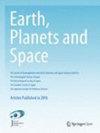流体对印度西部板块内地震带地震活动性的作用:大地电磁研究的电指纹
IF 2.5
3区 地球科学
引用次数: 0
摘要
在印度西部板块内地震带Koyna地震带(KSZ)沿东西向剖面进行的大地电磁(MT)调查显示,在极高电阻率(>20000 Ωm)花岗岩/花岗片麻岩基底。用灵敏度分析证实了这些异常中等导体的出现。震源沿电阻-导电边界的排列表明中导体为基底断层。将电阻率值转换为地震纵波与横波速度之比(v P / v s)表明,与周围基底相比,断裂带的中等导电性是由于断裂带中存在流体所致。地球物理证据显示,断裂带内流体含量为~ 2.5 ~ 3.6 vol%,孔隙度为~ 1.8 ~ 2.6%,流体沿构造边界运移,侵入力学强度强的基底,使断裂内部脆性破坏成核。本研究提出了Koyna地区地震活动性的两种机制。首先,由于附近Koyna水库的装卸引起的大气水循环是这次触发地震活动的潜在流体来源,这也是先前研究提出的。第二:由于流体循环有深层根源。本次MT研究发现了20 km以下的导电特征,认为这是由于含角闪孔岩石脱水而产生的。脱水产生的流体可能是触发地震活动的可能来源;因为导电特征与上地壳有联系。图形抽象本文章由计算机程序翻译,如有差异,请以英文原文为准。
Role of fluid on seismicity of an intra-plate earthquake zone in Western India: an electrical fingerprint from magnetotelluric study
Abstract The magnetotelluric (MT) investigation carried out in Koyna Seismogenic Zone (KSZ), an intra-plate earthquake region in Western India, along an E–W profile brings out moderately conductive (~ 700–1000 Ωm) near vertical features within the very high resistive (> 20,000 Ωm) granite/granite-gneiss basement. Occurrences of these anomalous moderate conductors are corroborated with sensitivity analysis. The alignment of earthquake hypocenters along the resistive–conductive boundary signifies the moderate conductor as basement fault. The conversion of resistivity values to the ratio of seismic P- to S-wave velocity ( v p / v s ) suggests that the moderate conductivity of the fault zone (as compared to the surrounding basement) appears due to the presence of fluid in the fault zone. Geophysical evidences reveal ~ 2.5–3.6 vol% fluid in the fault zone with ~ 1.8–2.6% interconnected porosity, which migrates along the structural boundary and invades the mechanically strong basement to nucleate the brittle failure within it. The present study proposes two mechanisms for the seismicity in the Koyna region. First: the meteoric water circulation due to the loading–unloading of nearby Koyna reservoir acts as potential fluid source for this triggered seismicity, which has also been suggested by previous studies. Second: the fluid circulation due to a deep-seated source. The present MT study brings out a conductive feature below 20 km depth which is thought to be emerged due to the dehydration of amphibole bearing rocks. The fluid generated from dehydration might act as a probable source to the triggered seismicity; since the conductive feature has a linkage to the upper crust. Graphical Abstract
求助全文
通过发布文献求助,成功后即可免费获取论文全文。
去求助
来源期刊

Earth, Planets and Space
地学天文-地球科学综合
CiteScore
5.80
自引率
16.70%
发文量
167
期刊介绍:
Earth, Planets and Space (EPS) covers scientific articles in Earth and Planetary Sciences, particularly geomagnetism, aeronomy, space science, seismology, volcanology, geodesy, and planetary science. EPS also welcomes articles in new and interdisciplinary subjects, including instrumentations. Only new and original contents will be accepted for publication.
 求助内容:
求助内容: 应助结果提醒方式:
应助结果提醒方式:


